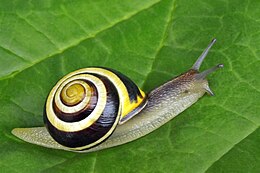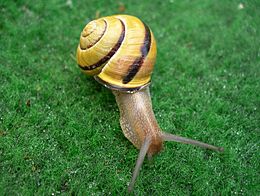Grove band snail
| Grove band snail | ||||||||||||
|---|---|---|---|---|---|---|---|---|---|---|---|---|

Grove cepaea ( Cepaea nemoralis ) |
||||||||||||
| Systematics | ||||||||||||
|
||||||||||||
| Scientific name | ||||||||||||
| Cepaea nemoralis | ||||||||||||
| ( Linnaeus , 1758) |
The grove snail ( Cepaea nemoralis ) - also Hain-Schnirkelschnecke or Banded Snail called - belongs to the family of Helicid (Helicidae) used to order the snails is expected (Pulmonata) and can easily with the closely related white-lipped snail ( Cepaea hortensis ) can be confused.
features
The housing of the grove is spherical in the overall habitus with a conical thread of medium height. The outer line is almost straight and up to about 5.5 turns are formed, which increase relatively quickly and evenly. The mouth drops rapidly from the spiral plane in the adult stage. The size of the housing is quite variable, in the adult stage it usually measures around 17 to 18 mm in height and 21 to 23 mm in width, rarely up to 28 × 32 mm. The navel is usually covered by the edge of the mouth, rarely a little open. The shell is usually relatively thick and firm. The surface is shiny and has fine, irregular growth stripes. The edge of the mouth seam is relatively thin and slightly curved outwards. It has a thickened lip on the inside and is brown to almost black on the outside. Specimens are rarely found that have a lighter rim (and can therefore easily be confused with the garden tapestry).
The basic color of the housing is usually bright yellow or brownish red, but often also white or yellowish. However, there are also other colorations. In Northern France, Belgium and the Netherlands, for example, a variant with a purple-brown base color is common. The case can be solid yellow or red-brown, but most often it has one or more (up to five) dark brown (or almost black) spiral bands. Individual bands can merge with one another or even be absent. The grove cepaea and the closely related garden cepaea ( Cepaea hortensis ) are among the most variable native land snails in terms of their color (color polymorphism ).
The basic color of the soft body ranges from yellow to dark gray and brownish, almost black. The wrinkles are usually darker than the basic color. Most specimens have a keel-like stripe on their back, which is usually a little lighter in dark animals and a little darker in light animals. The head and antennae are usually always darker than the rest of the body. The sole is colored light to dark gray, often with slightly darker side panels.
Similar species
The species is very easily confused with the closely related garden banded snail . However, other species are hardly considered. The main external difference to this is the dark case mouth; the garden ribbon snail has a light-colored housing mouth. However, there are (a few) exceptions, i. This means that some specimens of the grove banded snail can also have a light-colored mouth. Furthermore, the grove snail has three or fewer glandular appendages on the genital apparatus , whereas the garden snail has four or more. It is usually larger and the sideline is almost straight, in contrast to the garden banded snail, whose sideline is slightly curved. In addition, the blades of the love arrows on the grove ribbon snail are not forked, and on the garden ribbon snail they are forked.
Occurrence and way of life
The snail species is widespread in Western and Central Europe, especially in gardens, parks, cemeteries, but also in open woods, thickets, hedgerows and damp Hochstaudenfluren . In biotopes that are optimal for the species, colonization densities of up to 100 animals per m 2 were found. The vertical distribution ranges from the plain to the mountains. In the Alps it rises up to 1200 m, in the Pyrenees up to 1800 m. In the west, the Pyrenees form the southern border, then across southern France to the Alps. The northern limit of the distribution reaches in the British Isles central Scotland, in Scandinavia southern Sweden, southern Norway and southern Finland (mostly only the coastal areas). The eastern border in Central Europe was about the Oder, with the distribution area extending along the Baltic Sea to the former East Prussia. Originally it was largely absent in the Czech Republic. It occurs naturally along the southern border in the Italian Alpine regions, Austria and western Hungary. In the meantime, however, it has been widely carried off by humans (synanthropic). It is now also found in North America.
It feeds mainly on dead or rotted plant parts, but also on various fresh plants, algae and fungi. It has also been observed eating carrion, especially other dead snails.
Reproduction
The animals become sexually mature when the housing has reached its final size. Like all land snails, they are hermaphrodites that fertilize each other. But self-fertilization does not occur. Mating usually takes place in spring. Like other snails, they stimulate each other with a love arrow. This is square, the base is enlarged like a crown. The eggs are then laid from June to August in groups of 30 to 60 eggs in self-dug burrows. A total of up to 80 eggs are laid per animal per year. The oval to slightly elliptical eggs are whitish and have a lime shell. They measure 2.3 to 2.6 × 2.8 to 3.1 mm.
The juvenile snails hatch after about 3 weeks as finished small animals from the eggs. However, they only leave the cave after about 10 to 14 days. The housing of the young animals already measures 2.7 to 2.9 mm in diameter. The grove banded snail can reach an age of up to eight years.
Enemies
The grove banded snail has a large number of enemies. These include a number of birds, e.g. B. song thrush , red- backed bird , magpie , blackbird , starling , various types of crows , various types of seagulls, as well as ducks and chicken birds (e.g. the pheasant ). However, they are probably not the main enemies as they are diurnal and the snails are mostly nocturnal. Some of the bird species mentioned can only be captured by the snails if they crawl, i.e. This means that these species can only be considered as noteworthy snail predators on cloudy and humid days. Thrushes and magpies open the shells of the snails in so-called throttle forges on larger stones by hitting the shells on the stones. Mammals include the hedgehog and the shrew, which also eat shell snails (but not only the grove tapestry snail). Probably most of the losses are likely to be caused by frogs, newts and toads in suitable biotopes, which swallow especially young specimens whole. Among the arthropods, too, there are species that specialize in snails as prey, e.g. B. the larva of the firefly and various click beetles (e.g. Drilus concolor ). Predatory snails (e.g. the garlic snail ( Oxychilus alliarius )) also attack shell snails .
The grove banded snail is an intermediate host for the badger lungworm Aelurostrongylus falciformis .
swell
literature
- Klaus Bogon: Land snails biology, ecology, biotope protection. 404 p., Natur Verlag, Augsburg 1990 ISBN 3-89440-002-1
- Rosina Fechter & Gerhard Falkner: Mollusks. Mosaik-Verlag, Munich 1990 (Steinbach's Nature Guide 10), 287 pages ISBN 3-570-03414-3
- Ewald Frömming: Biology of the Central European Landgastropods. 404 p., Duncker & Humblot, Berlin 1954.
- Michael P. Kerney, RAD Cameron & Jürgen H. Jungbluth: The land snails of Northern and Central Europe. 384 pp., Paul Parey, Hamburg & Berlin 1983 ISBN 3-490-17918-8
Individual evidence
- ↑ Jonathan Silvertown et al .: Citizen science reveals unexpected continental-scale evolutionary change in a model organism. PLoS ONE, 6: e18927 2011 doi : 10.1371 / journal.pone.0018927 .
- ↑ Schnirkelschnecken (Helicidae) at www.weichtiere.at
- ↑ Hsueh-Wen Chang: Food preference of the land snail Cepaea nemoralis in a north American population. Malacogical review, 24 (1-2): 107-114, Whitmore Lake, Mich., 1991 ISSN 0076-3004
- ↑ Profile: Housing snails
- ↑ Joris M. Koene and Hinrich Schulenburg: Shooting darts: co-evolution and counter-adaptation in hermaphroditic snails. BMC Evolutionary Biology, 5:25 2005 doi : 10.1186 / 1471-2148-5-25 .
- ^ Fromming, p. 343
- ^ Roy C. Anderson: Nematode Parasites of Vertebrates: Their Development and Transmission . CABI, 2000, ISBN 978-0-85199-786-5 , pp. 164 .
Web links
- Grove ribbon snail at nabu.de
- Grove band snail at weichtiere.at
- Cepaea nemoralis inthe IUCN 2013 Red List of Threatened Species . Posted by: Neubert, E., 2011. Retrieved February 13, 2014.



